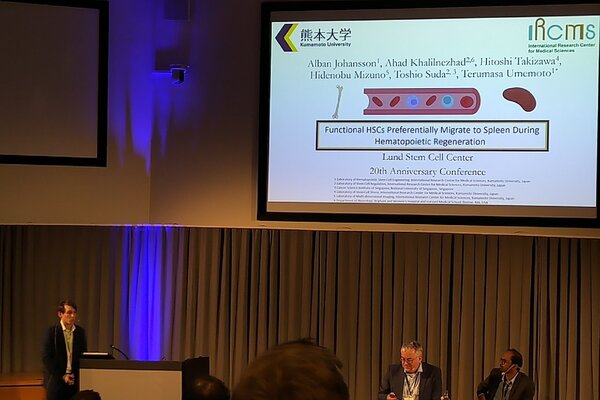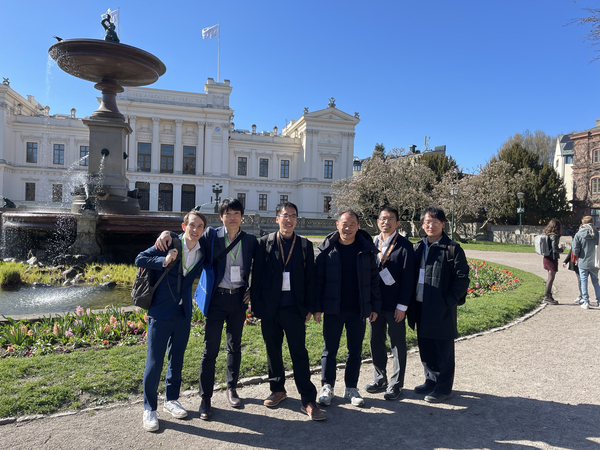- HOME
- Research exchange activities
- Dispatch of Researchers
- Mr. Alban Johanssorn visited Lund University (Sweden) and gave an oral presentation
Mr. Alban Johanssorn visited Lund University (Sweden) and gave an oral presentation
The following report was written by Mr. Alban Johanssorn (3rd year doctoral student, Faculty of Medicine, Kumamoto University).
Name: Alban Johanssorn
Laboratory of Hematopoietic Stem Cell Engineering, IRCMS
Research Institution: Lund Stem Cell Center
Dispatch Period: April 17th (Mon) - April 19th (Wed), 2023
LU Conference (2023/4/17-19) Summary Highlights D1/D2/D3
The first day of the conference was started by two plenary sessions that discussed ex vivo development of kidney (organoid systems) as well as therapeutic stem cell-based strategies for neurodegenerative diseases.
The second day started with Professor Green showcasing how identification of MPN driver mutations, such as JAK2V617F, as well as DNMT3A and PPM1D mutations commonly associated with clonal hematopoiesis. These findings will likely contribute significantly to our understanding of the genetic and molecular mechanisms underlying blood cancers and may lead to the development of new targeted therapies for these diseases. Prof. Michaela Frye continued the theme of strategies for cancer research by characterizing how RNA modifications which were one of the factors contributing to heterogeneous metabolic status in tumor cells, serving as a major mechanistic link between CD36-dependent metastasis-initiating cells. Afternoon session included talks by Simon Mendez-Ferrer who elaborated on the how they identified IL-6 as a driver of the cholinergic switch of bone-associated sympathetic neurons during postnatal development and a promoter of cholinergic signaling in response to physical activity during adolescence. A neurotrophic dependency is established between cholinergic nerve fibers and osteocytes relying on the GFRa2-neurturin (NRTN) axis. Bone-lining osteoprogenitors connected with the osteocyte network transmit and amplify the cholinergic signals in the bone marrow (BM). Lack of skeletal cholinergic nerve fibers causes osteocyte atrophy and osteopenia due to reduced bone formation, while increased IL-6 during exercise drives expansion of bone-anabolic cholinergic fibers. My oral presentation was well received and several questions from the audience helped me to improve.
The third day Hideyuki Okano discussed the incredible potential of neural stem cells for regenerative medicine in spinal cord injuries and how neural stem cell transplantation can rescue motor defects. The regenerative capacity of these stem cell transplants was demonstrated in non-human primates, i.e., common marmoset, after spinal cord injury. However, their group is still investigating to what extent the ratio of excitatory vs. inhibitory neurons in the graft (neuron cell sphere) plays a role. Other talks included new in vitro data from David Kent's group.
Taken together, there were many fascinating talks by renowned professors from many excellent institutions. However, for most of the plenary sessions, the balance between published data versus unpublished data was heavily weighted towards published stories, slightly hampering exchange of new ideas. If unpublished data would have been presented to a greater extent, presenters as well as audience could have benefitted more, in my opinion.
Core Facility 2023/4/20 Summary
We interacted with staff of the Lund University Stem Cell Center core facility to learn more about their recent upgrades/technical advancements. Furthermore, we briefly visited the bioinformatics core, led by Shamit Soneji who explained about their way of analysis.
Mini Symposium 2023/4/21 Summary Highlights
Göran Karlsson showed new data on how they separate LSCs types (BA+/-) based on scRNA seq. A discussion related to their newly developed Scarf tool for scRNA seq exploration ensued. Which might be adopted in Kumamoto University. Moreover, Nicholas Leigh presented their recent work on Salamander limb regeneration (Rag1 cancer suppressor gene, knock down impaired regenerative capacity). Lastly, Paul Bourgine showed latest work on bioreactor construction for ex vivo BM niche generation.



